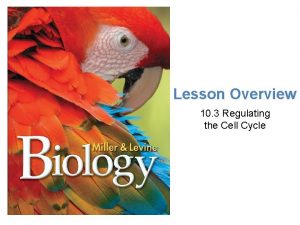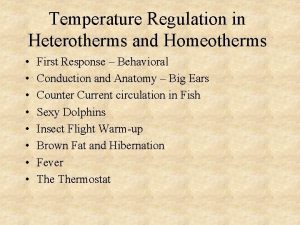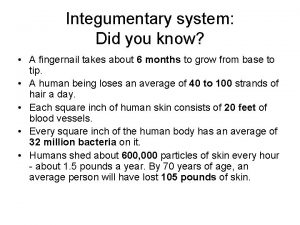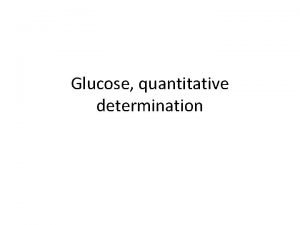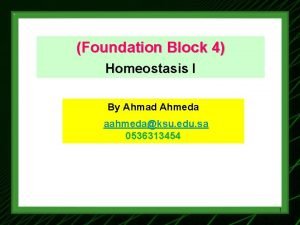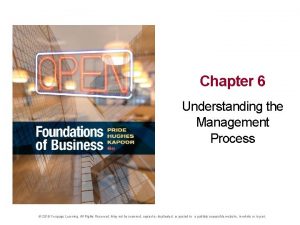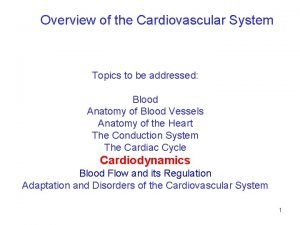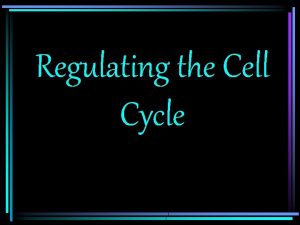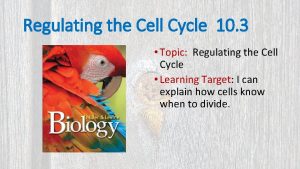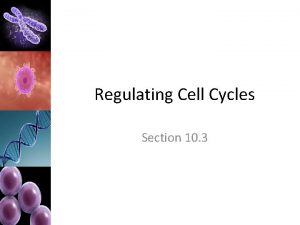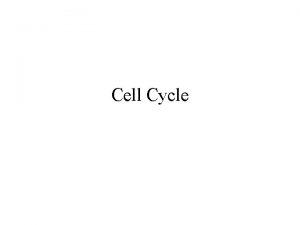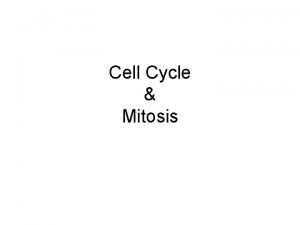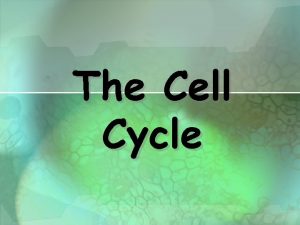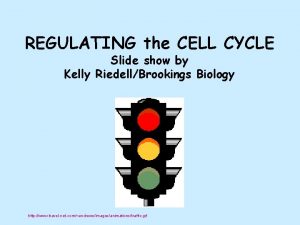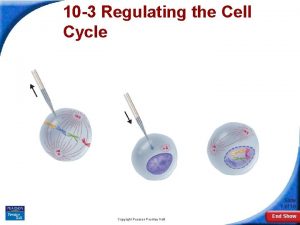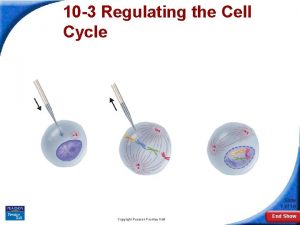10 3 Regulating the Cell Cycle Slide 1















- Slides: 15

10 -3 Regulating the Cell Cycle Slide 1 of 18 Copyright Pearson Prentice Hall End Show

10 -3 Regulating the Cell Cycle Controls on Cell Division Experiments show that normal cells will reproduce until they come into contact with other cells. When cells come into contact with other cells, they respond by not growing. This demonstrates that controls on cell growth and division can be turned on and off. Slide 2 of 18 Copyright Pearson Prentice Hall End Show

10 -3 Regulating the Cell Cycle Controls on Cell Division Contact Inhibition Slide 3 of 18 Copyright Pearson Prentice Hall End Show

10 -3 Regulating the Cell Cycle Regulators How is the cell cycle regulated? Slide 4 of 18 Copyright Pearson Prentice Hall End Show

10 -3 Regulating the Cell Cycle Regulators The cell cycle is regulated by a specific protein. The amount of this protein in the cell rises and falls in time with the cell cycle. Scientists called this protein cyclin because it seemed to regulate the cell cycle. Cyclins regulate the timing of the cell cycle in eukaryotic cells. Slide 5 of 18 Copyright Pearson Prentice Hall End Show

10 -3 Regulating the Cell Cycle Uncontrolled Cell Growth Cancer is a disorder in which some of the body's own cells lose the ability to control growth. How are cancer cells different from other cells? Slide 6 of 18 Copyright Pearson Prentice Hall End Show

10 -3 Regulating the Cell Cycle Uncontrolled Cell Growth Cancer cells do not respond to the signals that regulate the growth of most cells. Slide 7 of 18 Copyright Pearson Prentice Hall End Show

10 -3 Regulating the Cell Cycle Uncontrolled Cell Growth Cancer cells divide uncontrollably and form masses of cells called tumors that can damage the surrounding tissues. Cancer cells may break loose from tumors and spread throughout the body, disrupting normal activities and causing serious medical problems or even death. Slide 8 of 18 Copyright Pearson Prentice Hall End Show

10 -3 Click to Launch: Continue to: - or - Slide 9 of 18 End Show Copyright Pearson Prentice Hall

10 -3 The cell cycle is believed to be controlled by proteins called a. spindles. b. cyclins. c. regulators. d. centrosomes. Slide 10 of 18 End Show Copyright Pearson Prentice Hall

10 -3 Proteins that respond to events inside the cell are called a. internal regulators. b. external regulators. c. cyclins. d. growth factors. Slide 11 of 18 End Show Copyright Pearson Prentice Hall

10 -3 Once a multicellular organism reaches adult size, the cells in its body a. stop dividing. b. grow and divide at different rates, depending on the type. c. have the same life span between cell divisions. d. undergo cell division randomly. Slide 12 of 18 End Show Copyright Pearson Prentice Hall

10 -3 One effect of an internal regulator is that a cell will not begin mitosis until a. it becomes too large. b. the cell’s growth is stimulated. c. it is in physical contact with other cells. d. all its chromosomes have been replicated. Slide 13 of 18 End Show Copyright Pearson Prentice Hall

10 -3 One factor common to almost all cancer cells is a. a lack of cyclin. b. a defect in gene p 53. c. exposure to tobacco smoke. d. exposure to radiation. Slide 14 of 18 End Show Copyright Pearson Prentice Hall

END OF SECTION
 10-3 regulating the cell cycle
10-3 regulating the cell cycle Cell cycle
Cell cycle Heel toe heel toe slide slide slide
Heel toe heel toe slide slide slide Piloerection
Piloerection Regulating body temperature
Regulating body temperature Regulating blood glucose
Regulating blood glucose Regulating body temperature
Regulating body temperature The process of evaluating and regulating ongoing activities
The process of evaluating and regulating ongoing activities Control valve ppt
Control valve ppt Factors regulating cardiac output
Factors regulating cardiac output Section 10-2 cell division
Section 10-2 cell division Cell cycle and cell division
Cell cycle and cell division Biology.arizona.edu/cell bio/activities/cell cycle/01.html
Biology.arizona.edu/cell bio/activities/cell cycle/01.html Phases of cell cycle
Phases of cell cycle Factoring polynomials
Factoring polynomials Hát kết hợp bộ gõ cơ thể
Hát kết hợp bộ gõ cơ thể

